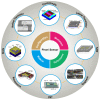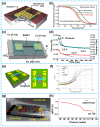Overview of the MEMS Pirani Sensors
- PMID: 35744559
- PMCID: PMC9228132
- DOI: 10.3390/mi13060945
Overview of the MEMS Pirani Sensors
Abstract
Vacuum equipment has a wide range of applications, and vacuum monitoring in such equipment is necessary in order to meet practical applications. Pirani sensors work by using the effect of air density on the heat conduction of the gas to cause temperature changes in sensitive structures, thus detecting the pressure in the surrounding environment and thus vacuum monitoring. In past decades, MEMS Pirani sensors have received considerable attention and practical applications because of their advances in simple structures, long service life, wide measurement range and high sensitivity. This review systematically summarizes and compares different types of MEMS Pirani sensors. The configuration, material, mechanism, and performance of different types of MEMS Pirani sensors are discussed, including the ones based on thermistors, thermocouples, diodes and surface acoustic wave. Further, the development status of novel Pirani sensors based on functional materials such as nanoporous materials, carbon nanotubes and graphene are investigated, and the possible future development directions for MEMS Pirani sensors are discussed. This review is with the purpose to focus on a generalized knowledge of MEMS Pirani sensors, thus inspiring the investigations on their practical applications.
Keywords: MEMS; Pirani sensors; functional materials; thermal conductivity; vacuum.
Conflict of interest statement
The authors declare no conflict of interest.
Figures









Similar articles
-
An Ultra-Compact MEMS Pirani Sensor for In-Situ Pressure Distribution Monitoring.Micromachines (Basel). 2022 Oct 7;13(10):1686. doi: 10.3390/mi13101686. Micromachines (Basel). 2022. PMID: 36296039 Free PMC article.
-
A Composite-Type MEMS Pirani Gauge for Wide Range and High Accuracy.Sensors (Basel). 2023 Jan 22;23(3):1276. doi: 10.3390/s23031276. Sensors (Basel). 2023. PMID: 36772316 Free PMC article.
-
A MEMS Pirani Vacuum Gauge Based on Porous Silicon.Micromachines (Basel). 2025 Feb 28;16(3):296. doi: 10.3390/mi16030296. Micromachines (Basel). 2025. PMID: 40141908 Free PMC article.
-
MEMS Acoustic Sensors: Charting the Path from Research to Real-World Applications.Micromachines (Basel). 2024 Dec 30;16(1):43. doi: 10.3390/mi16010043. Micromachines (Basel). 2024. PMID: 39858698 Free PMC article. Review.
-
Recent Advances of MEMS Resonators for Lorentz Force Based Magnetic Field Sensors: Design, Applications and Challenges.Sensors (Basel). 2016 Aug 24;16(9):1359. doi: 10.3390/s16091359. Sensors (Basel). 2016. PMID: 27563912 Free PMC article. Review.
Cited by
-
A novel high-performance wide-range vacuum sensor based on a weak-coupling resonator.Microsyst Nanoeng. 2025 May 21;11(1):98. doi: 10.1038/s41378-025-00937-z. Microsyst Nanoeng. 2025. PMID: 40393976 Free PMC article.
-
Charge Density-Based Pyroelectric Vacuum Sensor.Research (Wash D C). 2023;6:0028. doi: 10.34133/research.0028. Epub 2023 Jan 16. Research (Wash D C). 2023. PMID: 37040496 Free PMC article.
References
-
- Redhead P.A. Vacuum science and technology: 1950–2003. J. Vac. Sci. Technol. A Vac. Surf. Films. 2003;21:S12–S14. doi: 10.1116/1.1599870. - DOI
-
- Stach T., Johnson M.C., Stevens S., Burghaus U. Adsorption and reaction kinetics of SO2 on graphene: An ultrahigh vacuum surface science study. J. Vac. Sci. Technol. A Vac. Surf. Films. 2021;39:042201. doi: 10.1116/6.0001055. - DOI
-
- Li X., Shi Z., Behrouznejad F., Hatamvand M., Zhang X., Wang Y., Liu F., Wang H., Liu K., Dong H., et al. Highly efficient flexible perovskite solar cells with vacuum-assisted low-temperature annealed SnO2 electron transport layer. J. Energy Chem. 2021;67:1–7. doi: 10.1016/j.jechem.2021.09.021. - DOI
-
- Belič I. Neural networks and modelling in vacuum science. Vacuum. 2006;80:1107–1122. doi: 10.1016/j.vacuum.2006.02.017. - DOI
-
- Lasek K., Li J., Kolekar S., Coelho P.M., Guo L., Zhang M., Wang Z., Batzill M. Synthesis and characterization of 2D transition metal dichalcogenides: Recent progress from a vacuum surface science perspective. Surf. Sci. Rep. 2021;76:100523. doi: 10.1016/j.surfrep.2021.100523. - DOI
Publication types
Grants and funding
- 61771467/National Natural Science Foundation of China
- WX0301B013602210189PB/"Taihu Light" Scientific and Technological Breakthroughs (Industrial Foresight and Key Technology Research and Development)
- 2018153/Youth Innovation Promotion Association
- 2019B010117001/Key-Area Research and Development Program of Guangdong Province
LinkOut - more resources
Full Text Sources
Miscellaneous

